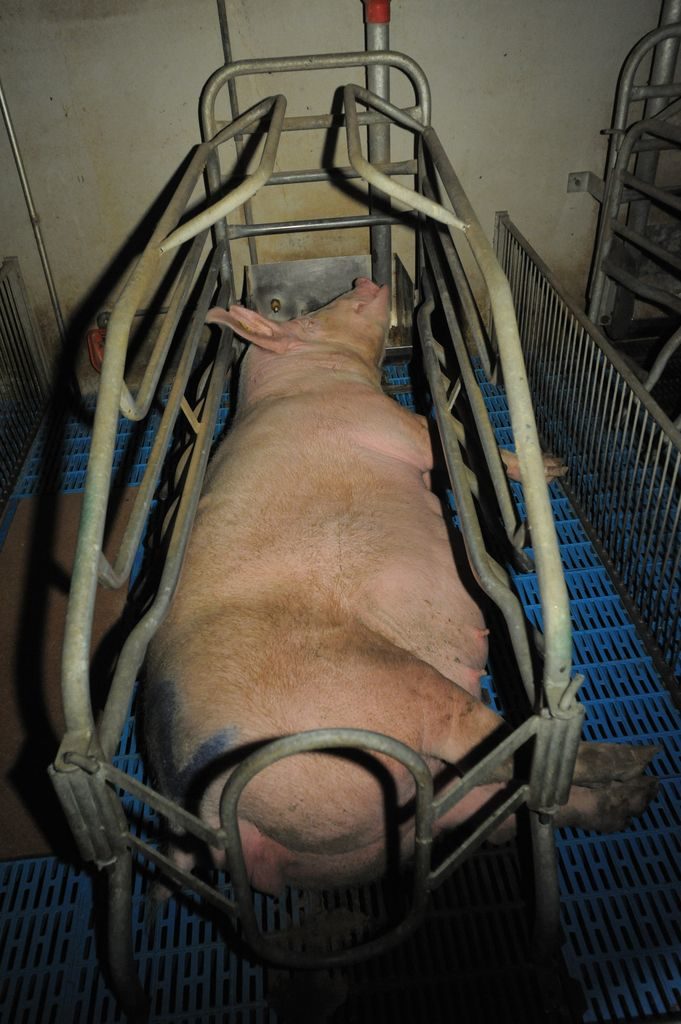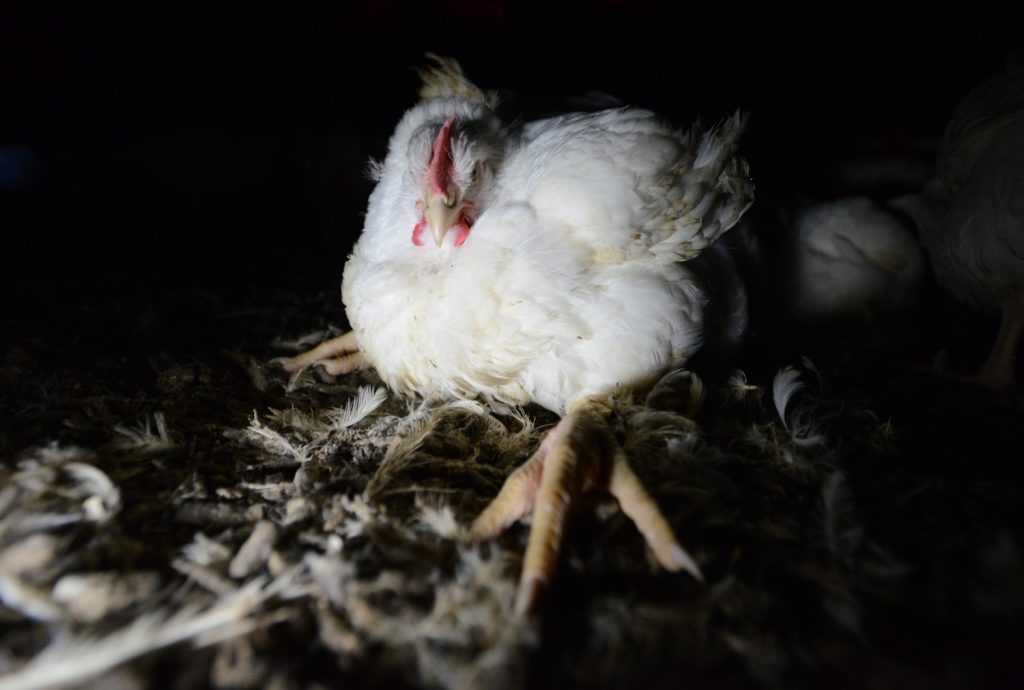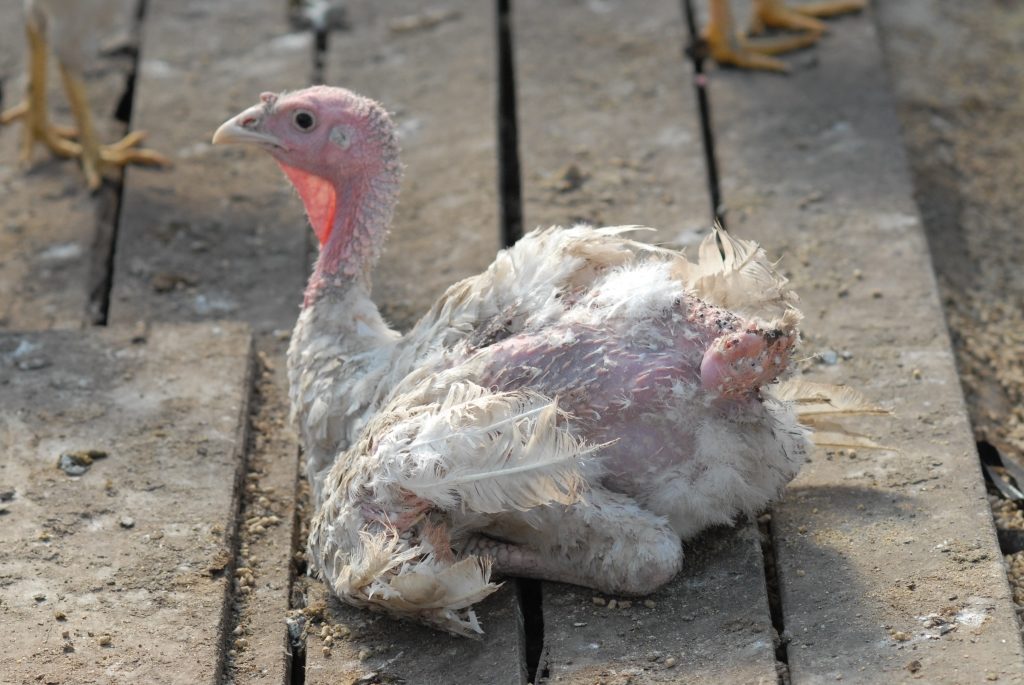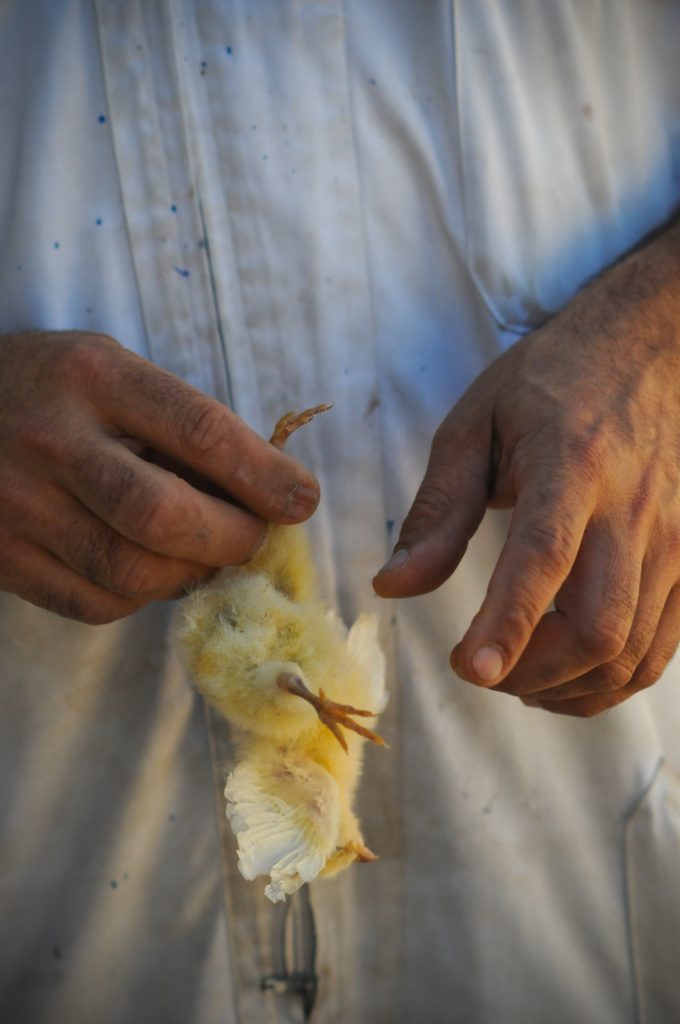Meat, milk and eggs produced under so-called ‘higher welfare’ schemes – including Freedom Food, free-range and organic – have become increasingly popular amongst consumers in recent years, thanks in part to high profile publicity campaigns by celebrity chefs such as Jamie Oliver and Hugh Fearnley-Whittingstall. These campaigns have helped bring the terrible conditions and appalling suffering inside factory farms to the attention of a mass audience. Consequently, many people are now choosing free-range and organic labels in an attempt to reduce animal suffering and ease their consciences. But how much do these schemes really benefit the animals?
The following article focuses on chickens and pigs because they are the species subjected to the most overtly intensive breeding and rearing regimes, and focuses on standards in the United Kingdom, though the conclusions drawn usually apply elsewhere as well.
Freedom Food
The Royal Society for the Prevention of Cruelty to Animals (RSPCA) is supposed to help animals but it has, instead, been involved in their intensive production and slaughter for the past decade through its Freedom Food scheme. The chickens and other animals kept in Freedom Food-approved hangar-like sheds eke out an existence little different from what animals experience in the mainstream, factory farm operations that they are meant to improve upon.
Chickens
The RSPCA’s welfare rules for broiler chickens (birds reared for meat) do not require that they have access to the outside – so Freedom Food does not mean free-range. The only noticeable difference between Freedom Food and mainstream intensive systems is that the birds must be provided with straw bales, perches and pecking objects. Overcrowding in Freedom Food farms is a significant problem, as 15 broiler chickens can be kept per square meter, which is only two birds fewer than in intensive conditions. For egg-laying hens, the number of birds permitted per square meter is the same for Freedom Food as for standard intensive units.
During a 2008 investigation into a Freedom Food chicken farm, Animal Aid found large numbers of lame, starving, dead and dying birds. Perches and straw bales remained stacked up against the wall during a number of visits. The perches were unusable by the majority of the birds and no pecking objects had been provided. Our undercover film was shown as the lead story on Channel Five news just days after the program had featured another investigation by Hillside Animal Sanctuary, which found similar problems on an RSPCA-approved egg-laying farm. Freedom Food farms are officially inspected just once a year.
Freedom Food rules state that only slow growing breeds of chicken can be reared. This is intended to prevent welfare problems associated with factory farming, such as leg disorders and heart failure.However, our investigation revealed that, by the age of seven days, many of the 30,000 chicks contained in the unit to which we made repeat visits already had painful hip and leg injuries. This prevented them from reaching water and food and caused their slow, painful deaths. Freedom Food birds are still selectively bred to reach slaughter weight in as little as 49 days. In the wild it would take three months for a chick to reach adult size.
Pigs

A sow in a farrowing crate, which is allowed under the RSPCA’s Freedom Food scheme. Image credit Jo-Anne McArthur / We Animals.
Not all pigs on Freedom Food farms are permitted access to the outdoors. As with chickens, Freedom Food does not mean ‘free-range.’ Shockingly, the RSPCA still sanctions the use of controversial farrowing crates in which sows are forced to give birth and suckle their young. These Medieval-looking contraptions are so small that sows can only stand, sit or lie for the entire duration of their confinement, usually around four weeks. They cannot step forwards or backwards, or turn around.
Tail docking, a routine mutilation under intensive regimes, is against RSPCA principles, but it is accepted in certain cases where there is a tail-biting problem. When pigs are kept in crowded conditions with no stimulation, they take out their boredom and frustration on their companions, and the easiest target is the tail.
Pigs who are kept outside are subject to another mutilation: nose ringing. This is done without any anesthetic and is to prevent the pigs from muddying up fields by carrying out their natural rooting behavior. Most outdoor pigs are given only a few square meters.
Free-Range
Chickens
The free-range label is confusing, as there are lots of different schemes that each have their own criteria. For example, ‘Traditional Free-Range’ requirements differ from ‘Free-Range’ by requiring more extensive open-air access, a lower stocking density and a greater minimum age at slaughter. ‘Free-Range –Total Freedom’ has similar requirements, but the birds must have unrestricted daytime open-air access.
These schemes make welfare provision for poultry that goes beyond the basic free-range criteria, as set out on the Defra (Department for the Environment and Rural Affairs) website. Basic free-range standards allow chickens bred for their flesh and eggs to be kept in sheds (13 and 9 birds per square meter respectively), as long as they have day time outside access (via pop holes in the side of the shed) for at least half of their lifetime.
A study of approximately 800,000 chickens kept on free-range farms in the UK found that, even though regulations require birds to have access to outdoor areas for at least eight hours a day, “the maximum number observed outside during daylight hours at any one time was less than 15 per cent of the total flock.” Chickens prefer ranging areas with trees and like to avoid bright sunlight. A wide, open field is simply not a preferred habitat. Domesticated chickens, much like their wild ancestors, need a habitat that provides shelter from wind, sun, and predators. Some chickens are simply too scared to go outside. Also, as there is no limit to the number of birds that can be kept in a shed, it is often difficult for some of the chickens to reach the pop holes. And some territorially aggressive birds may be guarding the exits. Those who do make it outside may struggle to cope with pathogens and weather conditions they encounter, as they are the same weakened, highly-bred strain of chickens as those in mainstream factory farms.
Chickens reared for their meat have other reasons why they don’t choose to go outside. Because they have been bred to put on large amounts of weight rapidly, their mobility is impaired and some may find it difficult to walk. Consequently, they do not venture far from the feed trough.

Broiler chickens are bred to grow so fast that, even at six weeks of age, some are unable to stand under the weight of their bodies. Image credit Jo-Anne McArthur / We Animals.
Beak trimming – a mutilation in which a third of the upper and lower beak is removed when the chicks are ten days old or less – is still permitted under free-range standards. The ‘meat’ chickens will be sent to slaughter at 56 days old. This is a slightly older slaughter age than factory farmed and Freedom Food birds, but still they are little more than chicks.
Pigs
A recent RSPCA-commissioned poll found that only two per cent of those questioned understand the terms used on pork products, terms such as ‘free-range,’ ‘outdoor bred’ or ‘outdoor reared.’ In fact, there is no legal definition or formal standards for free-range pigs, which means retailers can label pork products as ‘outdoor bred’ or ‘free-range’ without providing any explanation.
It is common for ‘free-range’ piglets to be born indoors because their mothers are kept housed to maximize their breeding potential. The sows give birth in farrowing crates and the piglets are reared outside.
‘Outdoor bred’ pigs are born outside, while their mothers stay throughout their breeding lives. The sows give birth in huts or pig arcs, which are usually lined with straw and also provide shelter. The piglets benefit from the free-range conditions until they are weaned at three or four weeks old, and then they are moved to indoor systems where the welfare standards can vary considerably.
‘Outdoor reared’ describes a system in which the piglets are born outside and have full access to the outdoors for up to 10 weeks of age before being moved to indoor rearing/finishing units. Ten weeks is still far short of the 17 weeks that pigs suckle and nurse their young in semi-natural conditions.
In the UK, 90 percent of all piglets are ‘finished’ in indoor fattening units. Here, the animals are kept in crowded conditions on slatted floors, which cause foot problems and deny the pigs the opportunity to root and explore.
Despite the lack of regulated standards in pig farming, the British government insists that there is no need for more rules and argues that pig welfare laws are already tighter here than in the rest of Europe. The British Pig Executive (BPEX) is a levy board that receives money from every pig slaughtered and uses it to promote the industry. Recently, the Advertising Standards Authority ruled that BPEX adverts showing healthy-looking pigs on thick straw or out in the fields with plenty of space to roam, which maintained that British pigs enjoy “very high standards,” were misleading and must not be used again. In 2008, Animal Aid investigated seven farms operated by BPEX directors and filmed very different scenes from those portrayed in their adverts. Among the scenes recorded by Animal Aid were pregnant and nursing sows incarcerated in farrowing crates; dead, sick and dying piglets littering the pens; animals wading through filth or living in utterly barren environments; a lack of bedding; and a lack of environmental enrichment, despite the law stating that this must be provided. And although routine tail docking has been prohibited in Britain since 1994, British farmers continue to flout this law. A 2008 report by the European Food Safety Authority found that 75-80 percent of British pigs are still tail docked.

Free range, organic turkey at a small farm in Canada. Despite what consumers may believe, these standards do not mean that animal products are cruelty-free. Image credit Jo-Anne McArthur / We Animals.
Organic
Just as free-range systems vary enormously, so there are also several ‘organic’ schemes linked to various certifying bodies, all with their own set of standards. There are minimum European Union standards that have to be met, but on top of those, certifying bodies can develop their own higher criteria. The Soil Association (SA) is the UK’s main certifying mark and its standards are among the highest in the world, especially in terms of animal welfare. However, organic farming is principally concerned with consumer satisfaction rather than animal welfare. It is about the (chemical-free) food fed to the animals and their medication regime. But because organic farmers cannot administer drugs routinely, unlike on most factory farms where they’re fed a cocktail of pharmaceuticals in an effort to keep them alive in the filth and squalor, it means they need to take greater care of the animals.
Under the basic EU standards, every animal must have access to the outdoors, weather permitting. Accommodation and bedding must meet the needs of the particular species, allowing them to perform their natural behaviors, such as nesting, rooting, dust bathing, etc. Practices associated with conventional farming methods, such as attaching elastic bands to the tails of sheep, cutting of teeth, trimming of beaks and dehorning must not be carried out systematically under organic farming rules. However, these activities may be authorized if they are said to be aimed at improving the health, welfare or hygiene of the animals. Slower growing breeds must be used in order to try to avoid the inherent illnesses caused when animals put on weight too quickly.
Under mainstream factory farming regimes, pigs are killed at around five months old. Under organic farming systems, they live longer and ‘boar taint,’ where the presence of testosterone in adult male pigs is said to affect the taste of the meat, becomes an issue. To avoid this ‘taint,’ organic standards permit the castration of male piglets – a painful mutilation – often without anesthetic.
Chickens
SA standards permit ten meat or six egg-laying chickens per square meter. The Association certifies farms with a flock size of up to 2,000 laying birds or 1,000 meat birds, but actually recommends no more than 500 for either. Basic EU organic standards permit up to 4,800 meat birds and 3,000 laying hens in one shed, which can lead to serious problems including feather pecking, bullying, and grave illness or suffering going unnoticed. With larger flocks there is greater pressure on the available pasture and therefore a greater likelihood of a parasite build up. As with ‘free range’ systems, some birds will never venture outdoors. EU organic standards state that poultry must have access to an open-air run for at least one third of their lives, but this need be granted only when weather conditions permit.
Although the Soil Association doesn’t usually permit the practice of beak-trimming, it has been found to be widespread on many organic farms. A survey by the RSPCA found that 19 out of 20 organic farms visited had laying flocks that had been beak-trimmed.
The minimum age at slaughter for organically reared chickens is 81 days, which is twice the age of ‘standard’ chickens, but still far short of their natural lifespan.
Pigs
Under basic organic standards, most piglets stay with their mother and siblings outside until they are sent to slaughter. However, the final fattening phase of organic pigs (and cows and sheep, as well) may take place indoors, provided that this indoor period does not exceed one fifth of their lifetime.
Nose-ringing is prohibited or restricted by UK organic certifiers, thereby allowing pigs to perform natural rooting and digging behavior. However,nose-ringing is practiced by organic pig producers in Denmark, from where many pig products in the UK are imported. Shelter is provided in the form of pig arcs, but this may be inadequate during extreme weather conditions. Artificial insemination is permitted under organic rules. This is not only a completely unnatural process for both sexes, but highly invasive.

A male chick is discarded on a free range, organic farm in Spain. This is standard practice on all types of commercial chicken farms. Image credit Jo-Anne McArthur / We Animals.
Slaughter
If meat is going to be marketed as organic, the animal must be slaughtered and butchered by operators who are registered with an organic inspection body and who are subject to annual inspection. Most organic farms use local slaughterhouses to minimize the distance the animals have to travel. However, the journey remains a terrifying ordeal for many, as is the process of slaughter, whether it’s at an organically approved abattoir or not.
And no matter the system under which the animals are reared, male chicks are still gassed or minced alive shortly after birth, as they are of no use to the egg industry, and male dairy calves, because they are unable to produce milk, are still shot at birth. When egg-laying hens’ productivity declines, their short lives will be ended to create cheap meat products.
Sustainable option
Animal farming uses up vast amounts of land, energy and water (see our Wrecking The Planet factsheet). With a rising human population consuming more animal products, animal farming is not sustainable in a world where resources are in short supply. The United Nations has reported that animal farming is responsible for 18 percent of global greenhouse gas emissions, more than the total generated worldwide by planes, cars and all other forms of transport. Some people argue that organic animal farming is the sustainable answer, but its output, and therefore the number of people who can be fed, is considerably less than that produced by mainstream factory farming methods, given the amount of resources needed.
In environmental terms, the factory-farmed chicken is more energy efficient than his free-range or organic cousins. Because of their short lifespan, fast growth and crowded housing – all of which cause terrible suffering – factory farmed chickens require 32 percent less energy per ton of meat to rear than organic birds. Housed animals give humans more control, so to some extent their diets can be manipulated to maximize growth and minimize polluting gases. But thankfully, people who care about environmentalism usually care also about the welfare and rights of animals. For those people, there is a healthy, nutritious and tasty dietary option that is less damaging to the planet and causes no harm to animals.
The compassionate choice
There is no humane meat. Animals’ lives are as important to them as ours are to us and none go to the knife willingly. Choosing organic, free-range or Freedom Food over standard meat, milk or eggs continues to cause pain and suffering, and wastes natural resources.
The only viable solution to end animal suffering and help protect the planet is to adopt an animal-free diet. Contact Animal Aid for a FREE veggie or vegan guide, including recipes, shopping tips and nutritional information.
Featured image: pigs look out curiously from their pen on a small farm in Ghana. No matter the type of farming, raising and killing animals for their meat is always cruel and unnecessary. Image credit jbdodane, CC BY-SA 3.0.





